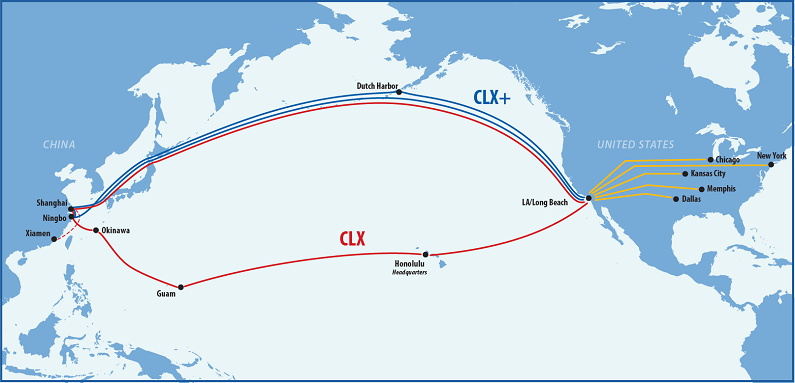China to North America
China to North America
Multimodal Logistics Routes from China to North America
I. Ocean Freight Routes
Ocean freight is the most common mode of cargo transportation from China to North America, offering advantages such as cost-effectiveness, large cargo capacity, and wide coverage. The ocean freight routes from China to North America are mainly divided into Eastbound Routes and Westbound Routes:
Eastbound Routes: Primarily traversing the Pacific Ocean, these routes depart from China's eastern coastal ports such as Shanghai and Shenzhen, and after several days of sailing, arrive at the west coast ports of North America, including Los Angeles and Seattle.
Westbound Routes: These routes pass through the Panama Canal or Cape of Good Hope, departing from China's eastern or northern ports and arriving at the east coast ports of North America, such as New York and Boston.
The transportation time by ocean freight from China to North America is relatively long, typically ranging from 20 to 40 days, depending on the ports in China and North America, as well as whether the service chosen is Full Container Load (FCL) or Less than Container Load (LCL).
II. Air Freight Routes
Air freight is the fastest mode of transportation, highly suitable for high-time-sensitivity goods such as semiconductors or pharmaceuticals. Although air freight costs are higher, it ensures rapid delivery of cargo. The air freight time from China to North America is relatively short, usually taking just a few days to reach the destination. Major Chinese cities such as Shanghai, Shenzhen, and Beijing offer direct flights or transit services to North America.
III. Multimodal Transportation
To improve logistics efficiency, multimodal transportation will increasingly be adopted for logistics from China to North America. Multimodal transportation refers to the organic integration of different modes of transportation (such as ocean, air, and land) to form a continuous and comprehensive integrated transportation process. In China, cargo can be transferred between modes of transportation via transit centers, significantly reducing transportation time and costs. For example, cargo can first be transported by ocean freight from China to a nearby North American port, and then transported by rail or road to the final destination.
IV. Other Considerations
Customs Clearance: Customs delays can add extra transportation time. Ensuring that all documents are accurate, complete, and up-to-date can reduce the risk of delays. Reliable freight forwarders can help simplify the customs clearance process and reduce the potential risk of cargo disruptions.
Port Congestion: Major North American ports may experience congestion during busy periods, affecting cargo loading, unloading, and transfer efficiency. Keeping up-to-date with port conditions can help predict potential delays in cargo transportation.
Seasonal Factors: During peak seasons, such as before the Chinese New Year or during North American holiday seasons, transportation times may fluctuate. Planning ahead for these busy periods can help effectively avoid cargo delays.
The multimodal logistics routes from China to North America include ocean freight, air freight, and multimodal transportation. Each of these modes has its own characteristics and is suitable for different types of cargo and transportation needs. When selecting a logistics route, it is necessary to comprehensively consider factors such as the nature of the cargo, transportation time requirements, and cost budget.

North America
| Shipping Channel | Duration |
|---|---|
| Standard Sea Eco | 45-55 days |
| Standard Sea | 30-35 days |
| Express Sea | 18-23 days |
| Air transport channel | Duration |
| Standard Air(带电渠道) | 10-15 days |
| Express Sea | 7-9 days |
| UPS,DHL Express | 3-5 days |
Get A Free Quote
In 24 Hours
Partner of Reputable Shipping Companies
 Shipping from China to Canada
Shipping from China to Canada Shipping from China to Mexico
Shipping from China to Mexico Shipping from China to USA
Shipping from China to USA

